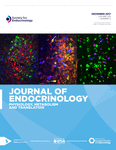PACAP is essential for the adaptive thermogenic response of brown adipose tissue to cold exposure
- Abdoulaye Diané,
- Nikolina Nikolic*,
- Alexander P Rudecki*,
- Shannon M King,
- Drew J Bowie and
- Sarah L Gray⇑
- Northern Medical Program, University of Northern British Columbia, 3333 University Way, Prince George, British Columbia, Canada V2N 4Z9
- Correspondence should be addressed to S L Gray; Email: Sarah.Gray{at}unbc.ca
-
Figure 2
Basal metabolic rate (BMR) and norepinephrine-induced maximal metabolic rate (MMR) under anesthesia in Pacap+/+ (females, n=8 and males, n=7) and Pacap−/− (females, n=5 and males, n=3) mice housed at 24 and 4 °C. Data are expressed as mean±s.e.m. *P<0.05 and **P<0.01 indicate a temperature effect (24 vs 4 °C within the same genotype).
-
Figure 5
Morphometric analysis of iBAT from Pacap+/+ (n=6) and Pacap−/− (n=5) mice following 3.5 weeks of cold exposure. (A) Hematoxylin and eosin-stained iBAT sections visualized at 60× magnification, along with their areal lipid proportions. (B) Visualization of vasculature in iBAT by fluorescence microscopy, along with vasculature quantification for both genotypes. *P<0.05 indicates a genotype effect (Pacap+/+ vs Pacap−/−).
-
Figure 7
Gene expression in iBAT of male Pacap+/+ (n=9) and Pacap−/− (n=8) mice after 3.5-week cold challenge. Target gene expression was normalized to three reference genes (18S (Rn18s), β-actin (Actb), and Gapdh). Data are expressed as mean±s.e.m. *P<0.05 indicates a genotype effect (Pacap+/+ vs Pacap−/−).
-
Figure 8
Gene expression in gonadal white adipose tissue (gWAT) and inguinal white adipose tissue (ingWAT) of male Pacap+/+ (n=9) and Pacap−/− (n=8) mice after 3.5-week cold challenge. Target gene expression was normalized to three reference genes (18S (Rn18s), β-actin (Actb), and Gapdh). Data are expressed as mean±s.e.m. *P<0.05 indicates a genotype effect (Pacap+/+ vs Pacap−/−).
- © 2014 Society for Endocrinology











